«- back to print version table of contents
Low-Level Mesocyclone
Detection
A mesocyclone is defined as a (usually cyclonic) concentration of vertical vorticity around 2–10 km in diameter within a convective storm. The vertical vorticity associated with a mesocyclone is often on the order of 10−2 s−1 or greater. It should be noted that a mesocyclone is not just any cyclone on the mesoscale; it refers specifically to cyclones within convective storms. Mesocyclones are frequently found in conjunction with the updraft and Rear Flank Downdraft (RFD) in supercells. Supercell tornadoes sometimes form in mesocyclones. Persistent mesocyclones that have significant vertical extent are detected by Doppler radar as mesocyclone signatures.
Use the radio buttons or click the image to switch between reflectivity and velocity imagery:
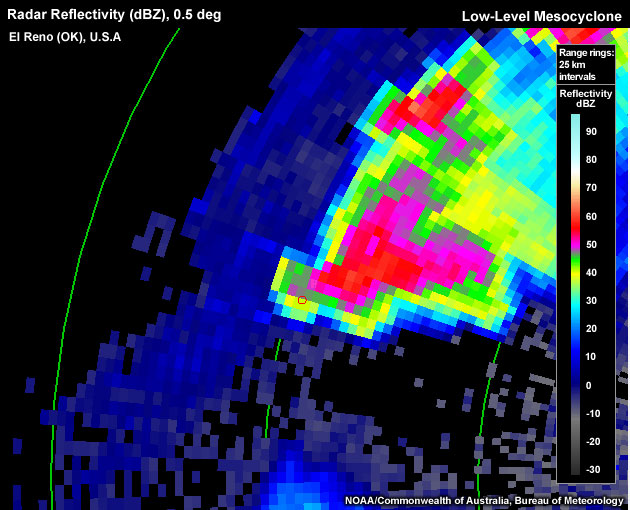
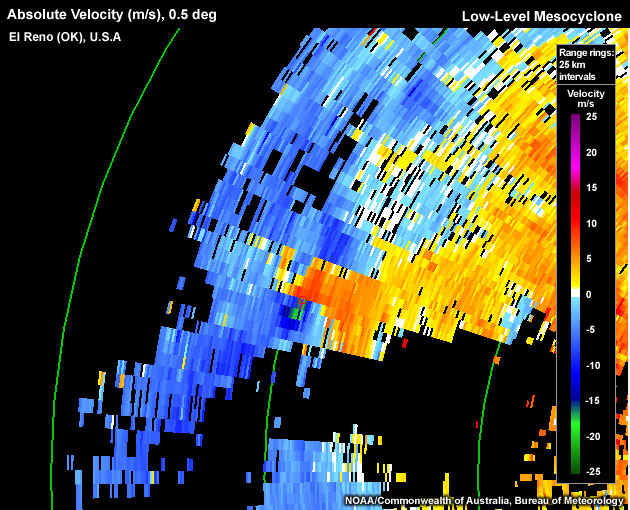
Strong anti-clockwise Low-Level Mesocyclone signature with a clear inbound/outbound couplet. The inbound branch shows aliasing. The mesocyclone is located near the southwestern corner of the low-level reflectivity core in this right-moving supercell.
A Low-Level Mesocyclone is a storm-scale, usually cyclonic circulation in the low levels of a thunderstorm that satisfies the mesocyclone definition. It is common to use the lowest couple of radar scans when attempting to detect this feature. Naturally, a Low-Level Mesocyclone would be found in the vicinity of the RFD and updraft in supercell thunderstorms. Remember that a supercell storm is any storm containing a mesocyclone.
For rotation within convective storms to be classified as a mesocyclone, the vortex generally needs:
- to be of storm scale (2-10 km in diameter),
- have reasonable (~3 km) vertical depth,
- have sufficient duration (two or more successive radar volume scans),
- and meet at least a minimum rotational velocity (~15 ms-1).
These criteria have been used as quantitative values in the National Severe Storms Laboratory (NSSL) and U.S. National Weather Service (NWS) mesocyclone definition.
To detect a Low-Level Mesocyclone you could use the following techniques:
Reflectivity: PPI/Plan View
Determining updraft location:
- Step up in elevation scans until you run out of >50 dBZ echoes.
- Step down one elevation scan.
- Centre cursor on the upshear side of >50 dBZ core (this is to account for storm movement in strong winds aloft which results in core movement between the lowest and storm top-level radar scans).
- Set a reference point.
- Step down to the lowest couple of levels of the thunderstorm. This reference point should be at the location where a mesocyclone would be expected. Now switch to velocity data.
Velocity: PPI/Plan View
- In the vicinity of the reference point, look for local inbound and outbound velocity maxima close to each other. Both velocity maxima should be at about the same range from the radar. Depending upon the component of the storm motion towards/away from the radar, the rotation may not be displayed as a symmetric inbound/outbound couplet but may show a possibly highly asymmetric couplet. Even without any storm motion, or in a storm-relative frame of reference, mesocyclones rarely manifest themselves as fully symmetric couplets. See the examples section for a demonstration of this couplet asymmetry.
Potential Difficulties in Detection
- Aliasing Observed radial velocities that are higher than the Nyquist velocity of the radar and therefore the value is phase shifted by half a wavelength, often display pixels as the opposite sign. If this is not detected, the forecaster may conclude the observed data is travelling in the opposite direction to which it actually is, hiding potential mesocyclone signatures.
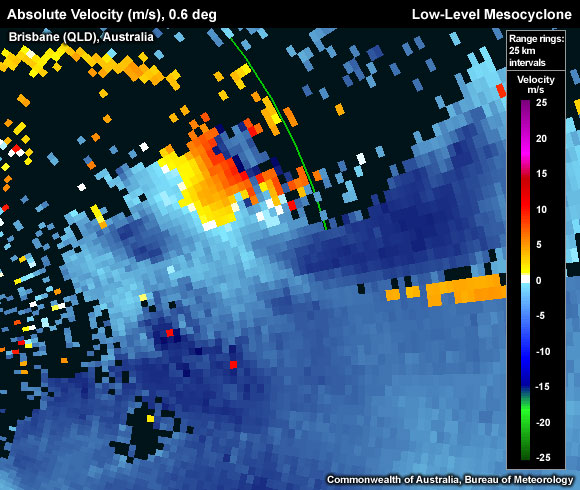
Cyclonic mesocyclone with aliased inbound velocity (dark blue).
- Rapidly translating mesocyclones - When either the storm is moving quickly or there is a strong background flow, a mesocyclone signature might be hard to recognise due to the often non-symmetrical inbound/outbound couplet. In some cases the entire signature may be all outbound (when the storm moves rapidly away from the radar) or all inbound (when it moves rapidly toward the radar). The signature may be composed, for example, of very strongly outbound velocity next to less strongly outbound velocity.
- Poor velocity data - Confidence in pixels, especially extreme values, is lowered; "hot pixels" are possible due to unfolding algorithm failures for radars that run dual pulse repetition frequencies. A check for spatial and temporal continuity can identify most velocity data contaminations of this type.
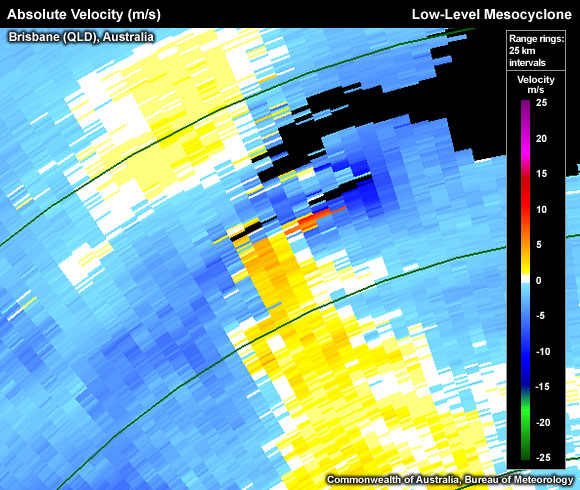
Cyclonic mid-level mesocyclone with unrealistic orange/red "poor quality" data pixels. Stepping up and down as well as forwards and backwards in time would reveal that these "hot pixels" suddenly appear and disappear, strongly indicating that these are not physical in origin but are radar artefacts.
- Resolution degradation as:
- Range increases Radar sampling degrades due to increasing beam width which increasingly smoothes out the sharp velocity gradients in a mesocyclone.
- Mesocyclone size decreases Radar sampling of the mesocyclone degrades for the same reason as above; "mini supercells" with small mesocyclones are particularly prone to this type of sampling problem ("partial beam filling").
- Timing of radar sampling Mesocyclone could exist for nearly 20 mins and only be captured on 1 scan for radars that take 10 minute volume scans.
- Beam Height:
- If the thunderstorm is far away from the radar it becomes increasingly likely that the radar beam overshoots the low-level mesocyclone (in addition to the beam width problems mentioned above).
Examples ofLow-Level Mesocyclones
Use the radio buttons or click the image to switch between reflectivity and velocity imagery:


Very clean and tight low-level mesocyclone rotating counter-clockwise associated with a right-moving supercell west of Oklahoma City on 24 April 2006. In a storm environment supportive of tornadoes, this signature would indicate a significant probability of tornadogenesis.
Use the radio buttons or click the image to switch between reflectivity and velocity imagery:
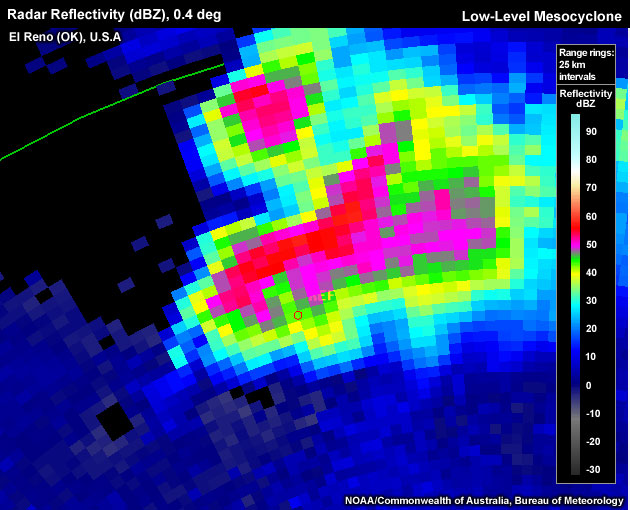
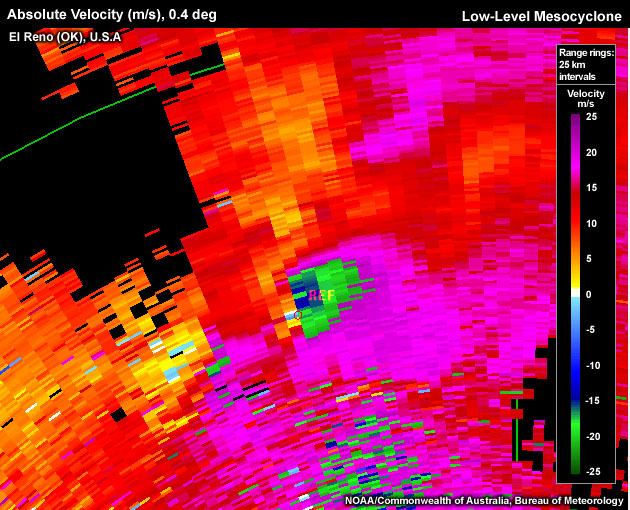
Base velocity signature of a anti-clockwise low-level mesocyclone in a supercell that is rapidly moving to the northeast (north of Oklahoma City, 3 May 1999). Due to the rapid translation of the signature, the inbound branch shows very weak values, whereas the outbound branch is strongly aliased.
Use the radio buttons or click the image to switch between reflectivity and velocity imagery:
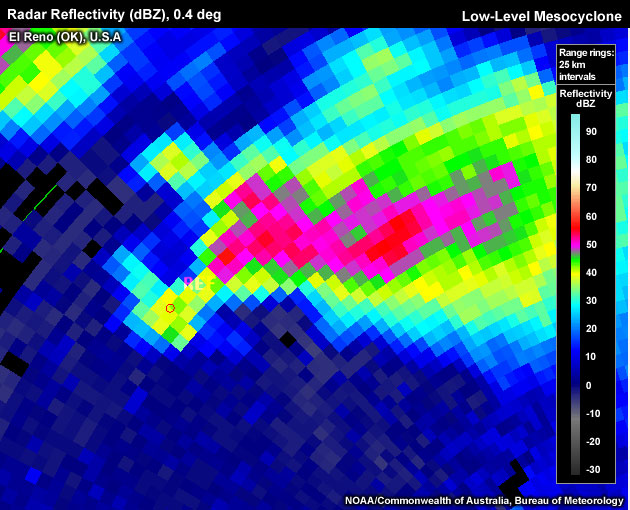
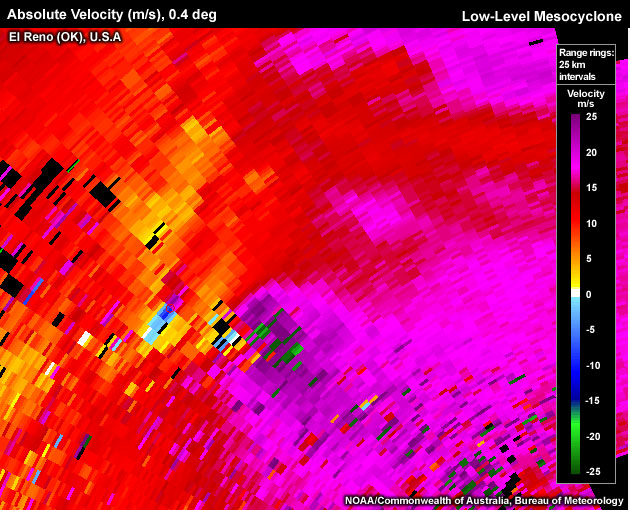
A tight anti-clockwise low-level mesocyclone in a supercell north of Oklahoma City on 3 May 1999. Note that the circulation centre is placed inside the extreme southwestern appendage to the main reflectivity core at low levels.
Low-Level Mesocyclone Look-a-Likes
- Poor velocity data - Most Australian Doppler radars use two pulse repetition frequencies (dual PRT) in order to increase their Nyquist velocity. Velocity data can therefore be affected by the performance of the unfolding algorithm, occasionally producing extreme values that are false. This example shows light blue pixels moving straight into red values, which implies too large an acceleration over a very short distance for a realistic situation. Moreover, the reflectivity data also suggests a rather non-severe looking cell.
Use the radio buttons or click the image to switch between reflectivity and velocity imagery:
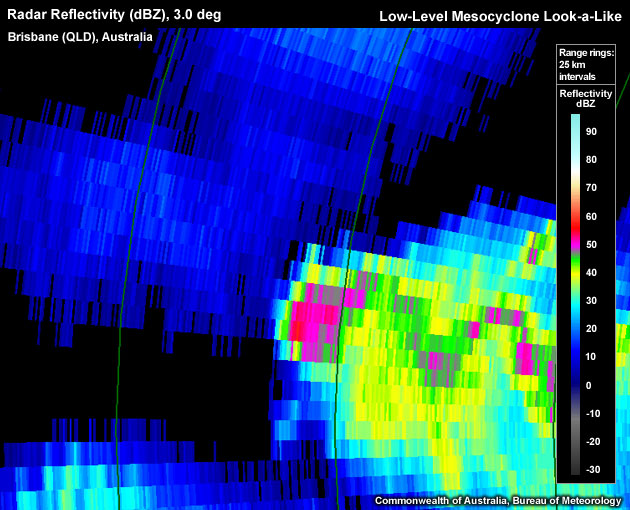
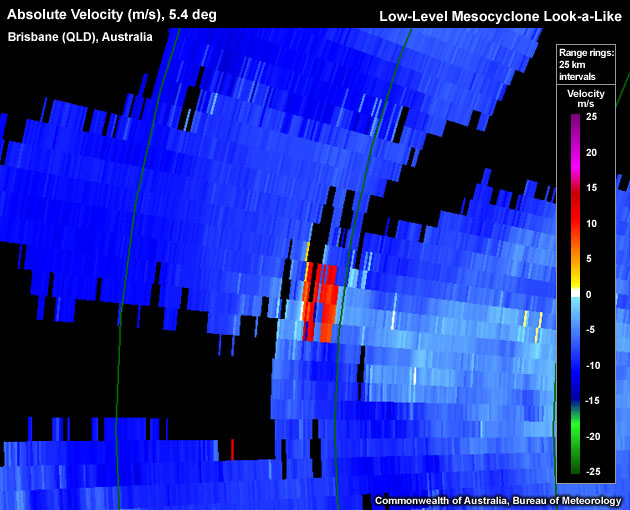
Corrupted velocity pixels that do not indicate rotation: step forward/backwards as well as up/down to confirm that this feature has no temporal or spatial continuity.
- Only shear - The rotational velocity is weaker than a minimal mesocyclone according to the mesocyclone nomogram (~15 ms-1).
Use the radio buttons or click the image to switch between reflectivity and velocity imagery:
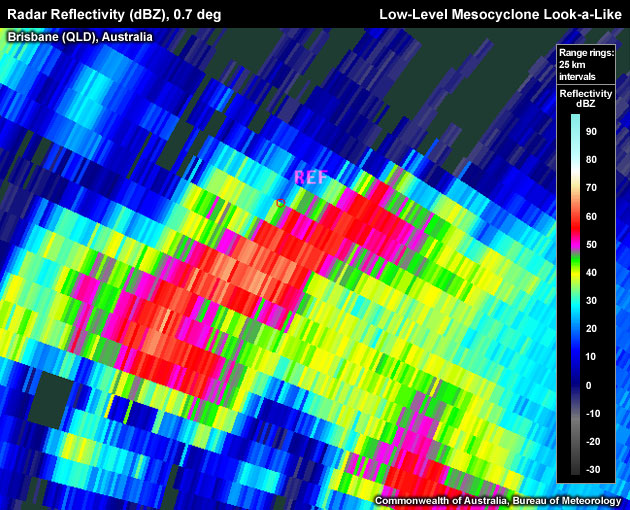
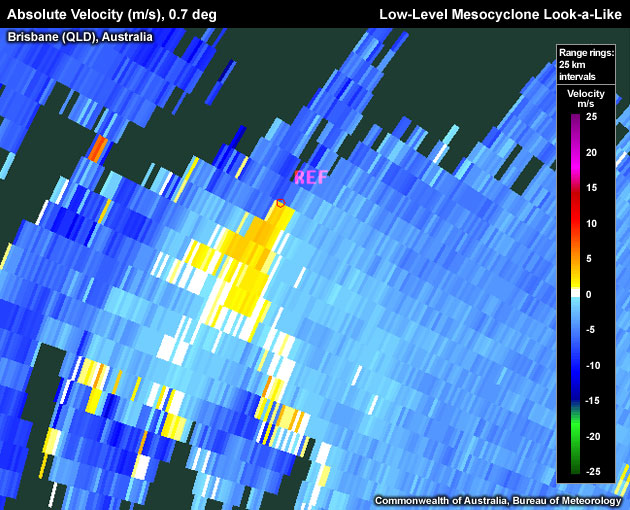
An intensifying storm shows a cyclonic circulation of insufficient rotational velocity for classification as a mesocyclone with outbound velocities of ~6 m/s, inbound velocites around ~13 m/s.
- Divergence/convergence - Can sometimes be confused with rotation. Note the white isodop in between the divergence or convergence signature.
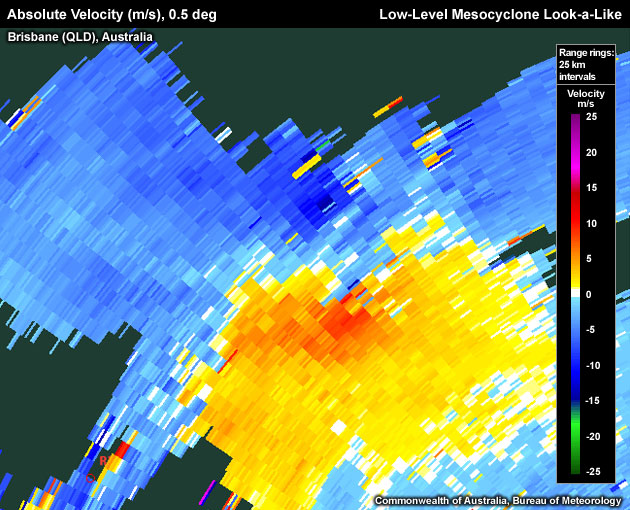
This image shows a hydrid signature between convergence and clockwise rotation with the convergent aspects being dominant.
- Not located in vicinity of updraft - To identify storm-scale rotation near the storm updraft, a true mesocyclone needs to be identified in the vicinity of such an updraft. Rotational signatures away from any updraft are therefore suspect.
Use the radio buttons or click the image to switch between reflectivity and velocity imagery:
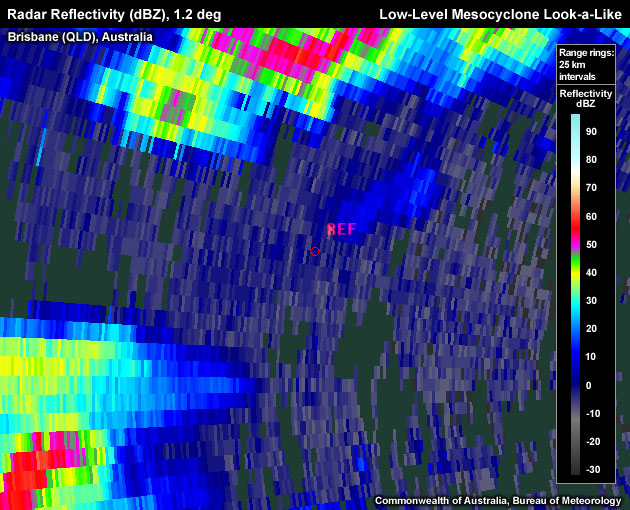

The velocity image shows what could be mistaken for a small but intense clockwise circulation. The corresponding reflectivity image confirms that the "circulation" is a radar artefact.
- No vertical extent ("single level vortex") - As detailed in the definition of a mesocyclone, a vertical depth of around 3 km or more is required for a mesocyclone.
- Too large a diameter - A broad area of rotation exceeding the 2-10km range might not represent a true mesocyclone but is more likely the result of larger-scale processes other than the tilting of horizontal vortex lines by an updraft.
Use the radio buttons or click the image to switch between reflectivity and velocity imagery:
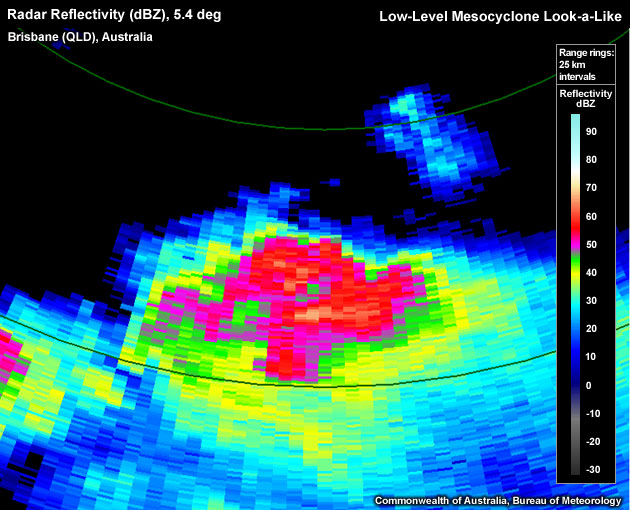
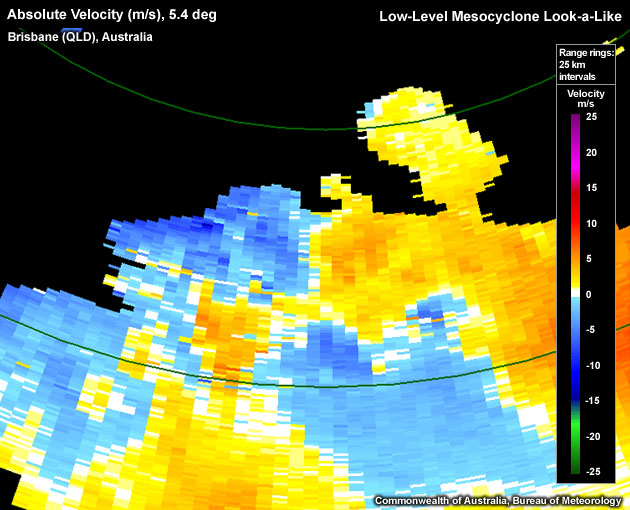
Broad area of rotation extending through the entire northern flank of the storm.
- Not persistent - A mesocyclone signature that is not evident for at least 10 minutes, is deemed not persistent enough for the signature to be classified as a mesocyclone.
Mesocyclones are the defining feature of supercell thunderstorms. To confirm that you are dealing with a supercell and anticipate its potential development and movement, see the Conceptual Model section.
Conceptual Model
A Low-Level Mesocyclone is usable as a defining radar signature for a supercell thunderstorm. The presence of a Low-Level Mesocyclone indicates small-scale rotation usually located near the interface between the Rear-Flank Downdraft (RFD) and the low-level updraft. This rotational flow is associated with the presence of vertical vorticity which has been created through tilting of ambient horizontal vorticity near the RFD gust front and subsequent stretching. The vorticity is enriched along the RFD gust front and, at least in part, generated by horizontal gradients in low-level buoyancy. The horizontal vorticity, once tilted by a strong low-level convective updraft, is subsequently stretched due to accelerating parcels in the same updraft.
A persistent Low-Level Mesocyclone signature indicates a strong and reasonably steady updraft associated with a supercell. Supercells generally can produce all four severe convective hazards used to define a severe thunderstorm in Australia (large hail, damaging winds, tornadoes and flash flooding). Many studies since the 1970s, including a more recent climatology in the United States on events that took place in 2007 (Duda and Gallus, 2010) conclude that supercells produce severe weather far more frequently than other storm morphologies, and also produce more intense severe weather.
An idealised depiction of a symmetric mesocyclone as it would appear in the velocity channel of a Doppler radar is shown in the figure below.
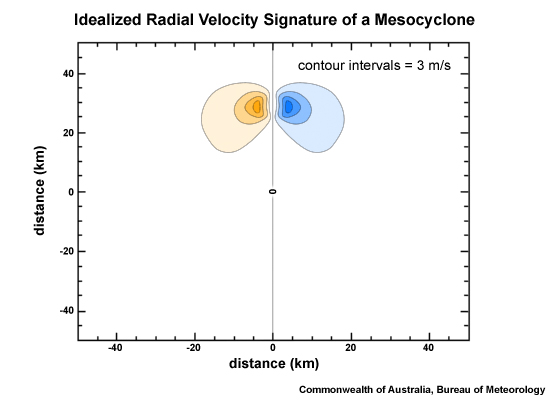
Idealised symmetric cyclonic (southern hemisphere) mesocyclone. The x and y axes show distance (km) from a radar origin at (0,0), and the radial velocity contour intervals are 3 ms-1.
The presence of a Low-Level Mesocyclone, especially when embedded in a storm environment of large 0-1km shear and high boundary layer relative humidity, is a significant predictor for supercell tornadogenesis. Trapp et al. (2005) found in their case sample that ~40% of low-level mesocyclone detections were tornadic. Other studies found that ~20% of supercells with low-level mesocyclones produce tornadoes.
In terms of tornadogenesis potential, the appearance of a low-level mesocyclone as a proxy for such potential should involve the consideration of the near-storm environment. Favourable environmental ingredients to support low-level tornadogenesis are large 0-1km shear (especially directional shear), good 0-1km CAPE and a high relative humidity boundary layer to prevent the rear flank downdraft cooling through evaporation/sublimation (Thompson et al. 2003; Craven and Brooks 2002).
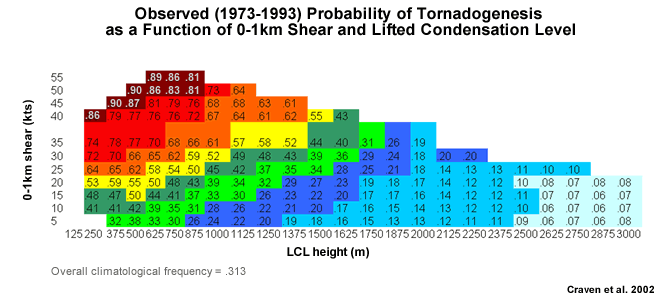
Probability of tornadogenesis as a function of two storm-environmental parameters: the 0-1 km shear and the height of the Lifted Condensation Level (LCL). Only 1800 LST soundings were used in the underlying climatology of Craven et al. (2002).
Determining Thunderstorm Classification
A significant, persistent Low Level Mesocyclone is associated with a supercell thunderstorm. To help determine or confirm the classification of the thunderstorm you are observing, use the following flow chart to help diagnose which thunderstorm conceptual model you should consider more closely.
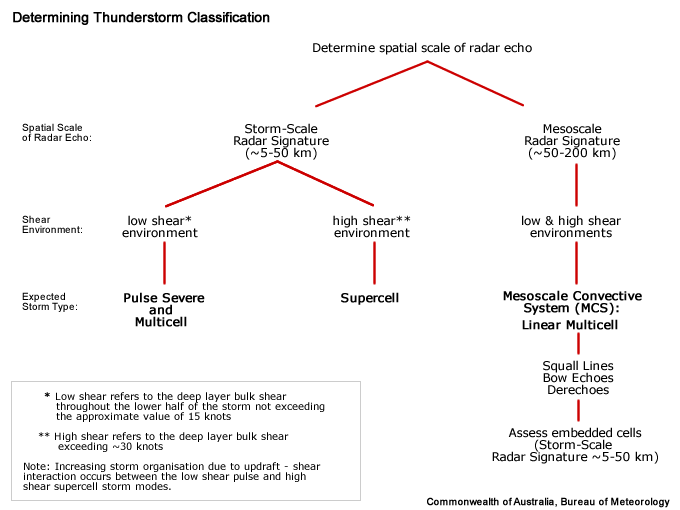
See Supercell for more information.
Diagnosis
Once you have confidently identified a Low-Level Mesocyclone signature, this section will help you estimate the storm severity associated with it. Generally, the spatial and temporal scales of a signature are loosely related to the updraft strength. In other words, the larger and/or more long–lived the signature, the stronger the updraft that produced it. In velocity-based signatures, updraft severity can usually also be gauged by the magnitude of the measured radial velocities. Examining a storm's overall temporal evolution will suggest whether the storm is becoming more or less severe. Radar signatures and associated storm developments can also be time-shifted relative to each other, as is the case in supercell tornadoes that occur during the collapse of the parent storm.
When comparing signatures to diagnose relative severity, keep in mind that it is assumed that signatures are sampled at equal ranges from the radar. Otherwise, a storm sampled at greater range (with a wider beam) can appear to be weak and/or weakening, while a storm sampled at a closer range (with a narrower beam) can appear to be strong and/or strengthening.
Degree of Severity
Mesocyclone severity has been studied extensively since the 1970s. A nomogram was developed by David Andra (1997) and others within the WSR-88D Operational Support Facility (OSF) which normalises the observed rotational velocity for range from the radar assuming the following characteristics of the radar and mesocyclone:
- The mesocyclone is approximated by a Rankine combined vortex
- The signature has a diameter of about ~6.5 km
- The radar has an effective half power beamwidth of 0.9 degrees
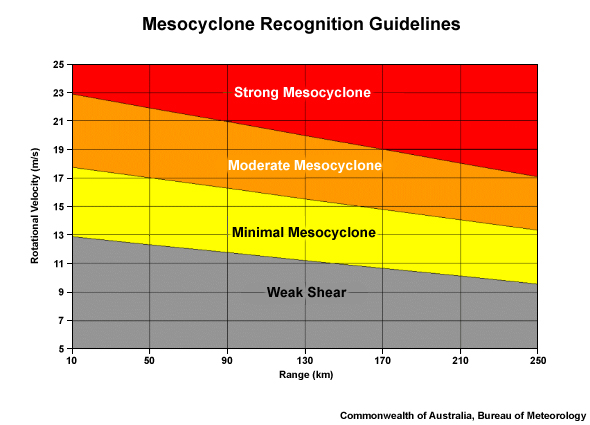
Subjective strength classification of a mesocyclone as a function of range from a radar origin (km) and mesocyclone rotational velocity (m/s). This nomogram is intended as a rough guide only.
To determine the mesocyclone strength, use Doppler radar to:
- Read off the maximum inbound and outbound velocities (e.g., inbound value of -25 ms-1 and outbound value of +15 ms-1). In the event that the velocity couplet has no sign reversal (i.e., both velocity extrema in the couplet are either inbounds or outbounds), read off both "extreme" values (e.g., outbounds of 35 ms-1 and 5 ms-1).
- Add the magnitudes of the two values together and divide by 2 to obtain the rotational velocity strength. The first example in (1) above yields a rotational velocity:
Vr = (|-25|+ 15)/2 ms-1 = 20 ms-1
For the second case above (no sign reversal):
Vr = (35 + 5)/2 ms-1 = 20 ms-1 - Determine the range the mesocyclone centre from the radar (in km).
- Using the rotational velocity and the range from radar, read off the strength of the mesocyclone in the nomogram.
A limitation to the mesocyclone nomogram is that it is specific to a 3.5 nm (~6.5 km) diameter mesocyclone. It is important to be aware of this limitation as the nomogram could underestimate/overestimate the intensity of the mesocyclone in those cases where the mesocyclone has a diameter significantly smaller/larger than 6.5 km. Further, the classification is subjective and depends on the radar beam width.
After classifying the strength of the mesocyclone, make sure the radar-detected rotation meets the remainder of the mesocyclone criteria:
- Diameter < 10 km
- Vertical extent > 3 km
- Persistence > 10 min
The mesocyclone strength nomogram is a subjective classification tool for assessing the strength of the mesocyclone. A Low-Level Mesocyclone is one of the few radar signatures that suggest directly that you should issue a severe thunderstorm warning based on the direct reading of the mesocyclone strength and the tight connection to a supercellular thunderstorm. In general, however, radar information should never be used in isolation and should always be considered in conjunction with the near storm environment and any reports.
Most Likely Convective Hazards
If a thunderstorm has been determined to be severe and possesses a Low-Level Mesocyclone, the following convective hazards should be considered to be included in the severe thunderstorm warning:
- Destructive winds a low-level mesocyclone is associated with a supercell thunderstorm with potential to produce a very strong downdraft. Destructive winds should be considered over damaging winds due to the supercellular classification (except: if you can confidently diagnose an elevated supercell the downdrafts of which are well insulated from the surface by a deep layer of potentially cold air).
- Large hail a particularly strong updraft has the potential to produce large hail, providing the updraft extends into the hail growth layer, -10ē to -30ēC. Some consideration to giant hail should be taken due to the supercellular classification of the thunderstorm.
- Heavy rainfall resulting in flash flooding flash flooding is not an automatic hazard associated with supercells, in particular for smaller or faster-moving storms. Supercells tend to have a comparatively low precipitation efficiency, but also process inordinate amounts of water vapour. The result of these two opposing drivers for heavy rainfall is that flash flooding is more likely with larger and/or slower-moving supercells.
- Tornado around 20% to 40% of low-level mesocyclones are associated with tornadoes. Stronger low-level mesocyclones, especially when embedded in tornadogenesis-supporting storm environments, warrant consideration of a tornado warning.
See Conceptual Models for more details on why particular severe weather should be included.
References/Addendum
Andra, D. L., 1997. The origin and evolution of the WSR-88D mesocyclone recognition nomogram. Preprints, 28th Conf. on Radar Meteorology, Austin, TX, Amer. Meteor. Soc., 364–365.
Burgess, D.W., R.J. Donaldson, and P.R.Desrochers, 1993. Tornado detection and warning by radar. The Tornado: Its Structure, Dynamics, Predictions and Hazards, Geophys. Monogr., No 79, Amer. Geophys. Union, 203-221.
Craven, Jeffrey P., Ryan E. Jewell, Harold E. Brooks, 2002: Comparison between Observed Convective Cloud-Base Heights and Lifting Condensation Level for Two Different Lifted Parcels. Wea. Forecasting, 17, 885–890.
Duda, J.D. and W.A.Gallus Jr., 2010. Spring and Summer Midwestern Severe Weather Reports in Supercells Compared to Other Morphologies. Weather and Forecasting, 25, 190-206.
Jones, T.A. et. al., 2004. Association between NSSL Mesocyclone Detection Algorithm-Detected Vortices and Tornadoes. Weather and Forecasting, 19, 872-890
Lee, Robert R., Anderson White, 1998: Improvement of the WSR-88D Mesocyclone Algorithm. Wea. Forecasting, 13, 341–351.
Trapp, R. J. et al., 2005. A Reassessment of the Percentage of Tornadic Mesocyclones. Wea. and Forecasting, 20, 680-687.